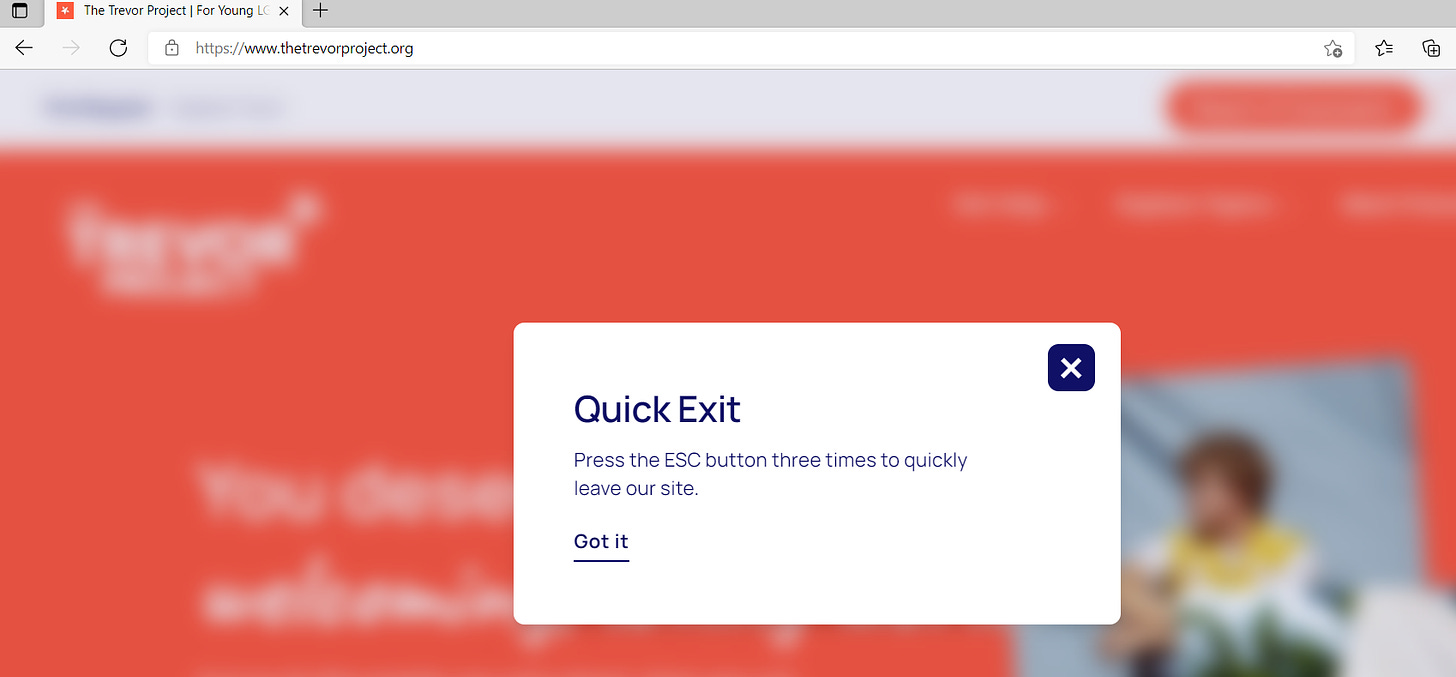It’s an honestly posed question. The Trevor Project started out nobly, with a raison d’etre that everyone agreed with: preventing young gay people from suicide. For unknown reasons, the Trevor Project does not provide that history on the current iteration of its website (in fact, what the CEO says is that the Trevor Project has been about young people struggling with “identities” since its inception), but according to Wikipedia, it started explicitly to help distressed gay youth: “The project was founded in 1998 [by] the creators of the 1994 Academy Award–winning short film Trevor, a dramedy about Trevor, a gay thirteen-year-old boy who, when rejected by friends because of his sexuality, makes an attempt to take his life. When the film was scheduled to air on HBO television in 1998, the filmmakers realized that some of the program’s young viewers might be facing the same kind of crisis as Trevor, and began to search for a support line to be broadcast during the airing. They discovered that no such helpline existed, and decided to dedicate themselves to forming the resource: an organization to promote acceptance of LGBTQ youth, and to aid in crisis and suicide prevention among that group.”
The original funding for the Trevor Project was quite limited: “The Trevor Lifeline was established with seed funds provided by The Colin Higgins Foundation and HBO’s license fee.”
While it still claims to serve gay youth, the Trevor Project has also branched out to young people identifying as trans; one could infer that it is now predominantly targeted to trans, perhaps due to who is currently funding it. (Michael Biggs has traced the change in funding focus, with money increasingly going to the T and less to the LGB, in similar organizations in the UK. Given the analogous skyrocketing rises in youth identifying as trans youth in both the UK and the US/Canada over the last decade, one can reasonably conclude, although admittedly not prove, a corresponding phenomenon also has occurred with Trevor Project funding.)
All that aside, what is especially worrisome is the website’s explicit premise that such distressed youth should be hiding potentially suicidal thoughts from their parents.
For instance, when you access the Trevor Project’s website, you are initially greeted with the following pop-up:






Why does the Trevor Project want to cut parents out of the process of helping their distressed children? Why does the Trevor Project think it knows better than parents? Shouldn’t parents of minors be the first to know if their child feels suicidal? Many of these vulnerable kids, particularly the gender-questioning ones, may have mental health comorbidities or may be struggling to accept themselves as gay. And social influence promoting trans identities – noted as recently as January 4, 2022 by former USPATH president and transwoman Dr. Erica Anderson in the San Francisco Examiner is undeniably at work. Does the Trevor Project encourage the youth who contact them to inform their parents, who likely love them and would bend over backwards to help? Why the assumption that parents are inherently unsupportive and bad, while Trevor Project knows all and knows best?
Further, The Trevor Project has established itself as an authority, and is considered by many an excellent source on suicide stats (though as noted elsewhere, these stats are dubious). However, they notably and consistently ignore contravening information, like this research:
Not social transition status, but peer relations and family functioning predict psychological functioning in a German clinical sample of children with Gender Dysphoria: “Peer problems and worse family functioning were significantly associated with impaired psychological functioning, whilst the degree of social transition did not significantly predict the outcome. Therefore, claims that gender affirmation through transitioning socially is beneficial for children with GD could not be supported from the present results. Instead, the study highlights the importance of individual social support provided by peers and family, independent of exploring additional possibilities of gender transition during counseling.”
How do prominent Trevor Project funders—many of whom are parents—feel about explicitly separating distressed LBGTQ youth from their parents? According to Wikipedia, these include: Melanie Martinez, Ellen DeGeneres, Troye Sivan, Kathy Griffin, Shay Mitchell, Daniel Radcliffe, Neil Patrick Harris, James Marsden, Chris Colfer, Kim Kardashian, Darren Criss, Dianna Agron, George Takei, Anderson Cooper, John Oliver, Tyler Oakley, and NFL player Carl Nassib. Many more celebrities are listed here.
I wonder how these celebs would feel about their own child hiding such vital health information from them, aided and abetted by the Trevor Project?
Given that decades have elapsed since the Trevor Project and its original mission were started and that nowadays the vast majority of North Americans are extremely accepting of LGBTQ people, one can only hope that at some point The Trevor Project stops latching onto misinformation and regurgitating the false narrative that parents of gender-questioning youth are the enemy.
The farthest thing from it: Parents are rather the main and lifelong supporters of their own children.
Originally published at https://pitt.substack.com/p/why-does-the-trevor-project-want reproduced by kind permission.

